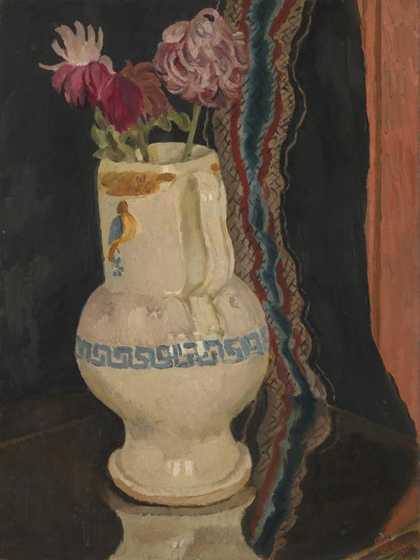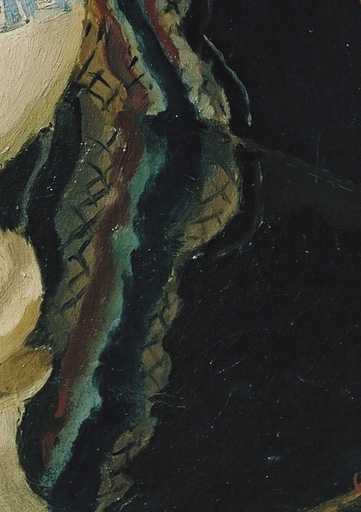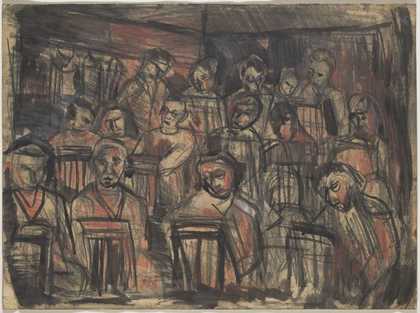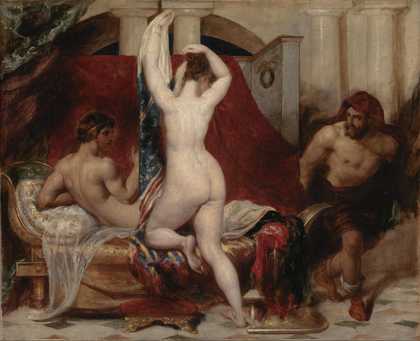Victoria Pomery on J.M.W. Turner’s The New Moon; or,‘I’ve lost My Boat, You shan’t have Your Hoop’
I love being by the sea – that feeling of space, of fresh air and being at one with nature. I’m very fortunate to live on the Kent coast, and in the past few months I’ve moved into a beautiful office designed by architect David Chipperfield, which looks directly out to sea. Four large-scale windows frame my view of a busy shipping lane, the remnants of Margate pier and the rocky outcrops of a chalk reef.
I’ve always been drawn to this work and its poetic title – the scene from my window is moments away from Turner’s view. The painting captures perfectly that sense of energy that empty sands and flat, open spaces provoke, as well as the contemplative atmosphere that the sea and sky induce. I remain surprised at the large expanse of sky from Margate beach, and quite often it is difficult to tell sea from sky. The two dogs leaping across the beach is a timeless and very familiar image. We sense their fun, enjoyment and liberation.

Joseph Mallord William Turner
The New Moon; or ‘I’ve Lost My Boat, You Shan’t Have Your Hoop’ c.1840 (detail)
Oil on mahogany
81.3 x 65.4 cm
© Tate
Perhaps what this painting does best for me is capture the special light of this coastline. It is hard to describe the quality of the light here – Margate looks north. It is soft, so much easier on the eye than the light of other coastal towns in the UK.
The hint of the new moon in the sky, reflected in the wet sands, is a subtle reminder of the strong relationship it has on the tide. Given our location, I’m especially looking forward to hanging this painting in our new gallery in 2012.
Corin Sworn on Vanessa Bell’s Chrysanthemums 1920

Vanessa Bell
Chrysanthemums (1920)
Tate
I first encountered the work of Vanessa Bell in a small paperback book on the Bloomsbury group. I flipped past the text and studied the old, slightly rough blackand- white photographs at the centre. In one, an expanse of field runs off into the distance, then meets a long stretch of bracken-covered hill. Its caption read: “The figure in the background is Virginia Woolf.” I searched the field and the ridge where the sky met the hill’s horizon, but the only mark that might have been the author was a hazy grey smudge. I bought the book.

Vanessa Bell
Chrysanthemums 1920 (detail)
Oil on canvas
61 x 45.7 cm
© Estate of Vanessa Bell
I thought of this image recently while sitting in an airplane delayed by thick fog. We taxied out along the runway and waited. Through my window I watched plane after plane slide horizontally along the ground, gather speed, then rise, merge with grey cloud and fade away altogether. Soon we too started our ascent and disappearance. In Vanessa Bell’s paintings landscapes often don’t situate reliably. The backgrounds keep distracting from their subjects, and my eyes keep wandering off. In this painting it is not the vase that claims my attention, but the curtain ribbon. It runs straight down the canvas, meets its reflection in the tabletop and, creating an inverse vortex, veers off along a looking-glass runway to elsewhere.
Peter Kennard on Leon Kossoff’s Saturday Morning Class, St Martin’s 1943–4

Leon Kossoff
Saturday Morning Class, St Martin’s (1943–4)
Tate
A detail of Leon Kossoff’s intense and powerful drawing of a Saturday morning drawing class at St Martin’s School of Art shows the rapt concentration of a single figure from the group. When I was in my teens, I went to Saturday morning class at the Byam Shaw School of Art, and became a fulltime student there in 1965 at the age of sixteen. It was at the time run by Maurice de Sausmarez, who inspired in me and countless others a belief in art as a social medium that is vital to humanity. I started teaching there in 1980. Byam Shaw was a special place that changed many people’s lives. It was one of those art schools where practising artists and students could meet, exchange ideas and relate as equals in a non-hierarchical environment.

Leon Kossoff
Saturday Morning Class, St Martin's 1943–4 (detail)
Ink and crayon on paper
38.6 x 52.2 cm
© Leon Kossoff
In the past decade, the school [like St Martin’s before it] stupidly allowed itself to be absorbed into Central Saint Martins, part of University of the Arts, London. Totally inappropriate marking systems were introduced by a clueless management of non-creative number crunchers who wouldn’t have lasted five minutes running a baked bean factory. Foreseeing its destruction, students admirably took over the school, occupying its buildings in February 2009 and proclaiming it the Byam Shaw People’s University in an attempt to save it from annihilation. Numerous exstudents sent their support. University of the Arts let the occupation run its course, but later its anger was expressed by destroying any autonomy left for the college. Students supporting the institution in which they studied became a major threat. Subsequently, many artists that taught there, along with technicians and administrative and maintenance staff, were cut in a managerial cull. Personally, I was told I was not needed for “unit delivery”. The Byam Shaw has just celebrated its centenary by witnessing its own obliteration.
What happened at Byam Shaw is, in microcosm, an extreme example of what is happening to our art colleges. The humanity expressed in Leon Kossoff’s drawing is what we’re losing. All of us who love art should fight the horrendous government cuts to fine art courses and the management stooges who are being brought in to sack the staff and destroy the studios.
Sarah Burnage on William Etty’s Candaules, King of Lydia, Shews his Wife by Stealth to Gyges, One of his Ministers, as She Goes to Bed c.1830

William Etty
Candaules, King of Lydia, Shews his Wife by Stealth to Gyges, One of his Ministers, as She Goes to Bed (exhibited 1830)
Tate
With its narrative of deceit, exploitation, voyeurism and vengeance, I have always found there to be something deliciously and wickedly appealing about Etty’s sumptuous retelling of Herodotus.
In the centre of the image we encounter the voluptuous and sensuous figure of Nyssia, who inadvertently performs a striptease before her morally bankrupt husband and his gullible minister. The striking beauty of her rich creamy flesh, the gentle curve of her spine and the balletic movements of her arms set a trap which I find impossible to resist. With every perceptible movement she takes further into picture plane, I find myself inextricably stepping closer and closer to the canvas. Now within touching distance, my gaze becomes transfixed by the delicacy of the brushwork and the rotund fleshiness of her buttocks, which boldly stand out against the rich reds of the background. As I strain to view the small canvas, my body starts to mimic the sinister hunch of the voyeuristic Gyges, and I find myself similarly creeping up on the unwitting Nyssia, stealing an illicit glimpse of her naked form. While this makes me complicit in Candaules’s act of betrayal, like Gyges, I am unable to resist the temptation to linger a little longer. Indeed, though I know that I should morally shun the exploitation of the female form, virtuously recoil at the voyeurism and condemn the misogynistic culture which endorsed this work, I find myself utterly unrepentant and unapologetically itching for more.

